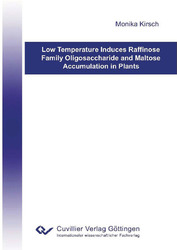| Fachbereiche | |
|---|---|
| Buchreihen (96) |
1378
|
| Nachhaltigkeit |
3
|
| Gesundheitswesen |
1
|
| Geisteswissenschaften |
2365
|
| Naturwissenschaften |
5406
|
| Mathematik | 229 |
| Informatik | 319 |
| Physik | 980 |
| Chemie | 1363 |
| Geowissenschaften | 131 |
| Humanmedizin | 243 |
| Zahn-, Mund- und Kieferheilkunde | 10 |
| Veterinärmedizin | 108 |
| Pharmazie | 147 |
| Biologie | 835 |
| Biochemie, Molekularbiologie, Gentechnologie | 121 |
| Biophysik | 25 |
| Ernährungs- und Haushaltswissenschaften | 45 |
| Land- und Agrarwissenschaften | 1004 |
| Forstwissenschaften | 201 |
| Gartenbauwissenschaft | 20 |
| Umweltforschung, Ökologie und Landespflege | 148 |
| Ingenieurwissenschaften |
1793
|
| Allgemein |
98
|
|
Leitlinien Unfallchirurgie
5. Auflage bestellen |
|
Erweiterte Suche
Low Temperature Induces Raffinose Family Oligosaccharide and Maltose Accumulation in Plants
Monika Kirsch (Autor)Vorschau
Inhaltsverzeichnis, Datei (38 KB)
Leseprobe, Datei (210 KB)
Cold stress is amongst the most important abiotic stress factors affecting growth and development of plants in temperate zones. It slows down many enzymatic reactions and may be deleterious to cells due to ice crystal formation. Plants respond and adapt to cold stress through various biochemical and physiological changes collectively termed cold acclimation; i.e. a series of genetically programmed adaptation mechanisms take place during low, non-freezing temperatures. Former observations made in cold-treated Ajuga reptans and Arabidopsis thaliana plants formed the basis of this thesis, consisting of three topics.
(1) Cold treatment of A. reptans plants resulted in an increase of raffinose family oligosaccharides (RFOs; α-1,6 galactosyl extensions of sucrose) and its biosynthetic enzyme activities in leaves. In this thesis, I investigated the effects of cold treatment on the RFO metabolism of roots of hydroponically-grown plants and hairy root cultures of A. reptans. The RFO concentrations increased about 5-fold (to 31 and 19 mg/gFW, respectively) in both root systems after 42 d in the cold (8/3°C, 12/12 h). The RFO biosynthetic enzyme activities of galactinol synthase (GolS), stachyose synthase and galactan: galactan galactosyltransferase (GGT), but not raffinose synthase increased slightly in hydroponic roots after 42 d in the cold. All those enzymes showed more pronounced increases in activity in cold- treated hairy root cultures with GolS showing the highest increase and absolute activity (57-fold increase to 1 nkat/gFW). The activities of GolS and GGT correlated positively with the measured expression levels (only these two genes were investigated) in hydroponic roots, but not in hairy root cultures, where the opposite was observed. To my knowledge, the cold-induced RFO increase described here is the first report on the response of the primary metabolism in hairy root cultures.
(2) Cold treatment of Arabidopsis plants results in a rapid, transient increase in maltose (Malt, α-1.4 glucosylglucose) concentration in leaves. The origin of this Malt is traditionally assumed to be β-amylase-mediated degradation of starch. In this thesis, I provide evidence for a direct Malt synthetic pathway employing the enzyme maltose synthase (MaltS) which synthesizes Malt from α-glucose-1-phosphate (α-Glc-1P). MaltS activity seems to be widespread in the plant kingdom as indicated by its presence in leaves of several dicotyledonous and monocotyledonous species. Arabidopsis leaf MaltS had a pH optimum of 6.5 in MES-buffer, a Km value of 3 mM for α-Glc-1P, a temperature optimum in the range of 15 to 30°C and a very high specificity for α-Glc-1P, compared to Glc and β-Glc-6P. Comparing MaltS activity of Arabidopsis leaf protoplasts with vacuoles and chloroplasts isolated from them, it is concluded that MaltS is most probably a cytosolic enzyme. The physiological role of MaltS is still unclear; its activity remained unchanged during both day/night transitions and cold treatments of Arabidopsis leaves. The purification of MaltS proved difficult and all attempts to determine its sequence by an elaborate LC-MS/MS approach remained unsuccessful.
(3) Cold treatment of the Arabidopsis knockout mutant of the chloroplastic transporter CarbT6 (At5g59250) had resulted in a phenotype, not observed in wild-type plants. Earlier functional expression of CarbT6 in yeast cells had indicated a Glc-transport capacity. As an extension of that study, the biochemical characterization of CarbT6 was planned using the same yeast cell functional expression system. Unfortunately, no transport activity could be measured anymore, although CarbT6 was expressed (as evidenced by positive transformation with GFP-tagged CarbT6) and both transformed cells and vesicles isolated from them were used for transport experiments.
| ISBN-13 (Printausgabe) | 3869551712 |
| ISBN-13 (Printausgabe) | 9783869551715 |
| ISBN-13 (E-Book) | 9783736931718 |
| Buchendformat | A5 |
| Sprache | Englisch |
| Seitenanzahl | 142 |
| Auflage | 1 Aufl. nicht vollfarbig drucken!!! |
| Band | 0 |
| Erscheinungsort | Göttingen |
| Promotionsort | Universität Zürich |
| Erscheinungsdatum | 15.12.2009 |
| Allgemeine Einordnung | Dissertation |
| Fachbereiche |
Biologie
Land- und Agrarwissenschaften |








